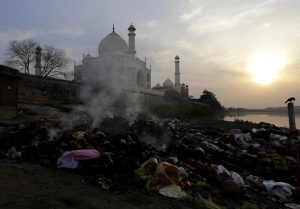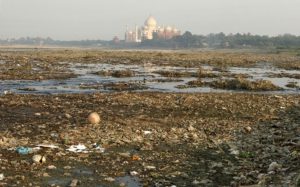Taj Mahal: A Wonder In Danger
Left Uncared, the Taj Mahal is dying a slow death and it's high time we sit up and take notice.
Kalinga TV News Network
By- Md. Mojahid Raza
Bhubaneswar: ‘A Tear Drop on the cheeks of Eternity’, ‘A wonder in marble’, ‘Love Story in Marble’, ‘The Most Beautiful Building in the World’- these are a few common eulogies associated with the Taj Mahal. Built between 1632-1653, this white marble mausoleum was commissioned by the fifth Mughal emperor of India Shah Jehan, in the memory of his beloved wife Arzumand Bano Begum or ‘Mumtaz Mahal’ who died while giving birth to their 14th child.
Standing majestically on the banks of river Yamuna in Agra, this building of heavenly beauty is considered a symbol of true love and fidelity. It is one of the most visited places in the country and is features in the list of the seven wonders of the world.
However, a visit to Taj Mahal today will leave you shocked, stunned and depressed. Once famous for its architectural glory and matchless beauty, the building now depicts a sad picture- broken minarets, cracked walls, damaged turrets, fast eroding structure and polluted environs.

The Taj Mahal, over the years, has become a victim of neglect, apathy, and indifference; trapped between the crossfire of politics and religion which have robbed it of its sheen and are pushing it towards destruction.
This slow and steady degradation is a result of the disinterest in preserving the world heritage structure. The Supreme Court’s July 16 verdict is an eye-opener which makes it concretely evident that the government has failed to protect the Taj Mahal from impending dangers.
The potential dangers to the Taj Mahal were first figured in the 1980s. Combustion of fossil fuels, smoke, automobile exhaust and pollutants from Mathura Oil Refinery were turning the milky white marble building black. Luckily, this was acknowledged and timely actions were taken- relocation of oil refineries and prohibition of vehicles near the Taj and the declaration of a 10,400 sq. km area in the vicinity of the Taj Mahal complex as ‘Taj Trapezium Zone’.
However, over the years, the threats to Taj have changed forms and the structure now remains vulnerable due to various other factors which have threatened its existence.
The monument is now threatened by encroachment, deforestation, solid waste dumps, garbage, falling water levels of Yamuna, Acid rain and pollution. The Taj, which was once milky white is now turning yellowish and its exquisite stone carvings have developed green and brown patches. The marble inlay work has also turned black because of the smoke and fumes arising from the nearby burning ghats and automobile exhausts. Archaeologists and historians have also claimed that the foundation of Taj Mahal is also weakening due to a diverse factors and that immediate action is needed in this regard.

Governmental authorities, including the Archaeological Survey of India(ASI) and the Government of Uttar Pradesh claim that they are leaving no stone unturned to protect the Taj. But Supreme Court’s July verdict is a concrete evident of the fact that these efforts have failed to produce any desirable results.
A love poem in stone that once symbolised an emperor’s fantasy of love, glory and magnificence is fighting a fierce battle for survival in the age of modernity. It is not everyday that great wonders like Taj Mahal are built. Signs of danger are all around. The monument of love, the most valued jewel of Indian culture and Indian architecture is in danger. The signs are alarming dreadful and its high time we realise it before the catastrophe strikes and Taj Mahal becomes a wonder of fables.




 Ms Kalinga
Ms Kalinga